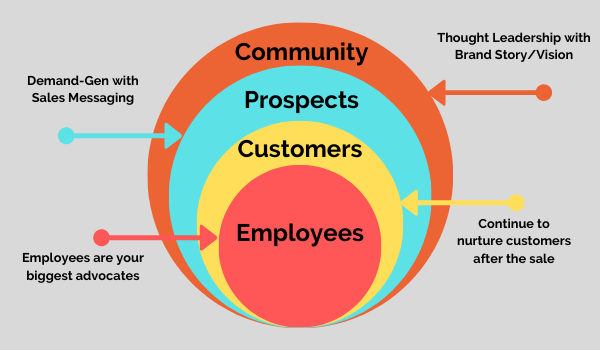It is that time of year! Marketing organizations are planning and budgeting for 2020. As you work through your process, remember that you have four major audiences that you need to address - employees, customers, prospects, and community. Although you may have done this exercise in previous years, it is important to revisit it on an annual basis. Markets change - sometimes rapidly.
Last week at the Sales Empowerment Summit for Women, I had a “fireside” chat with CMO-extraordinaire, Jeanne Hopkins, who is currently CMO at lola.com. Jeanne shared her thoughts on how to structure a communication program. Coincidentally, we take the same approach at Red Javelin.
Think of your audiences as concentric circles.

Employees – Regular communication with employees is the key to getting everyone in the company on the same page. They are your biggest advocates! Every employee, especially customer facing, should be aware of news and new campaigns before it hits the market. If sales, support, and the executive team are not aware, it puts them in a position of becoming blind-sided by prospects and customers who have seen the campaign or news. It undermines any trust they have developed with customers and prospects. In addition, when every customer-facing employee is talking about your news/promotion, it begins to develop momentum as it hits externally. Leverage your employee’s social media reach. All it takes is an email or a regular newsletter to keep them informed.
Customers – The sale doesn’t end with a PO. Sources quote the cost of acquiring new customers is 3-30 times more expensive than upselling to your existing customer. That is a huge range but it is dependent on what you are selling, the complexity of the sale, and the length of the sales cycle. The point here is that it costs more, a lot more than upselling to your customer base. When you become your customer’s “go-to” source for trusted information, your brand is always top-of-mind when it comes to future purchases. Customer marketing takes the form of events, newsletters, email, and direct touch with phone calls and personalized notes.
Prospects – This circle represents your prospects – people that expect to buy within the next year. These are prospects that understand they have a problem and are looking to solve it. This is pure lead gen and nurturing using a variety of tactics to move them closer to the sale.
Community – This circle includes everyone else and is the primary focus for brand building. It includes the media, influencers, analysts, investors, potential prospects, partners, and just about anyone else in your ecosystem.
Within each of these categories are different people, with different motivations that influence the sale. Many of the personas will overlap categories however, some personas that will always remain in a single category. For example, in IT technology, analysts play a role in educating large enterprises on vendors and technologies. Analysts will not become prospects or customers.
Personas that cross the community, prospects, and customer categories are people involved in the decision process of the sale.
The next step is to develop detailed buyer personas. A persona is a representation of prospective buyers and influencers who exhibit similar behavioral patterns in their purchasing decisions, behaviors, attitudes, goals and motivations, regardless of age, gender, education and other typical demographics.
Take a deep dive and profile everyone that touches the buying cycle. Once identified, the marketing team needs to understand clearly each persona’s pain points and their motivation. For example, if there is an engineer in the buying cycle, they care about features and functionality whereas the purchasing agent cares more about getting the best deal because their bonus is dependent on it. Both influence the sale but their motivations are different.
This is the first post in a series. The next post will talk about Sales Messaging versus Brand Story. Stay tuned.




